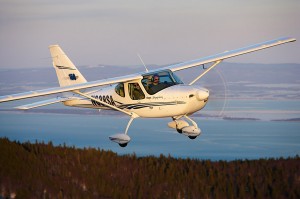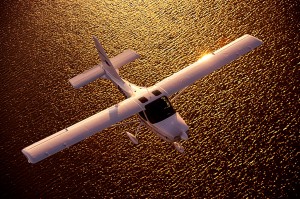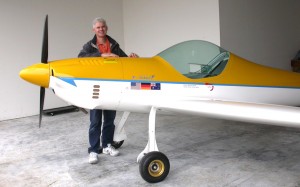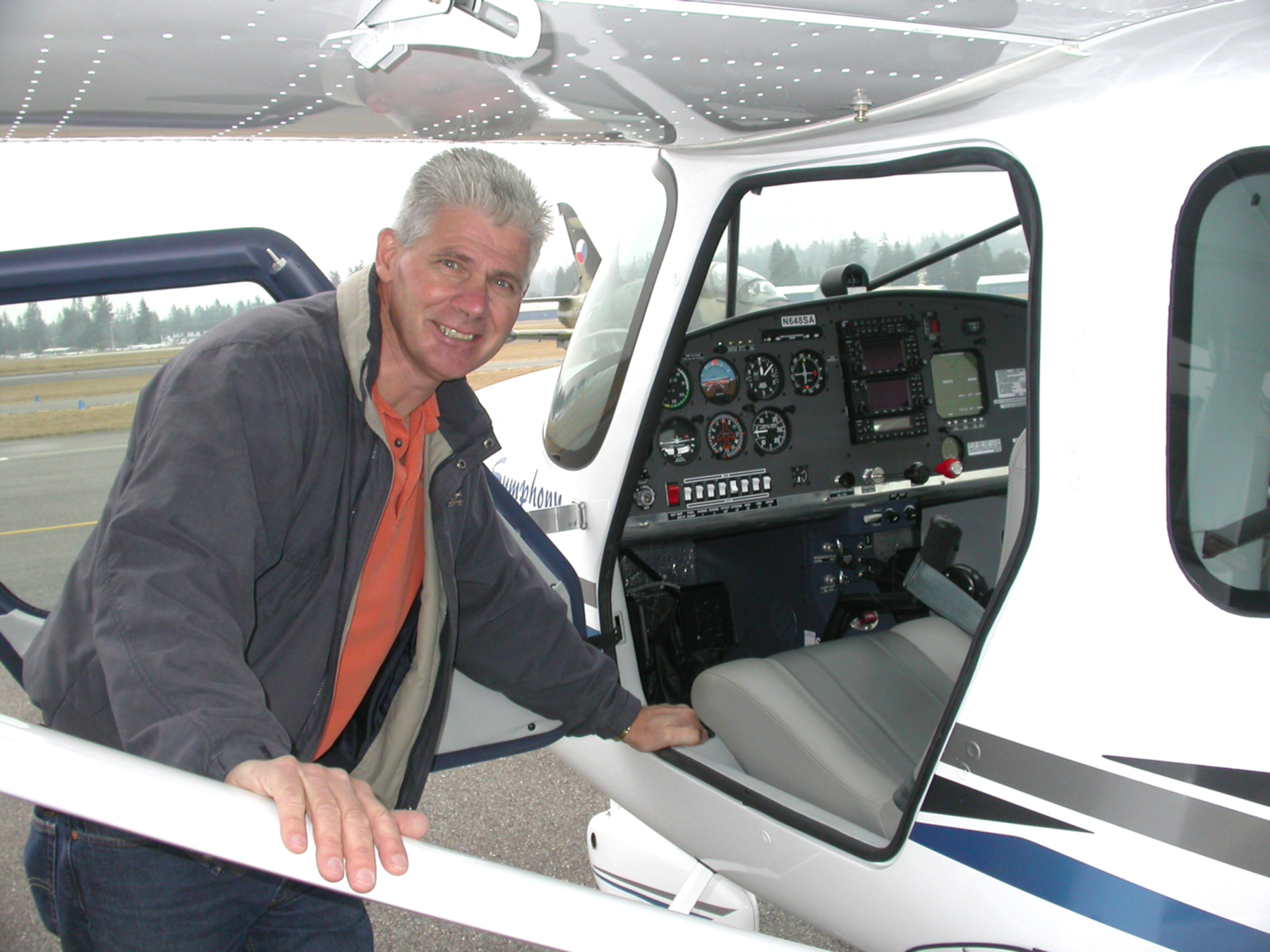By Terry Stephens

Through Pacific AeroSport, Chris Klix sells new models of Symphony aircraft. This one has a wide cabin and wing struts behind the door to provide more side visibility.
Christian Klix, a composites expert, is something of a composite himself. He’s a complex mix of aviator, technician, builder, engineer, aircraft repairman and keen business entrepreneur.
Equally at home in the cockpit of a sailplane or a new engine-powered Symphony aircraft, Klix operates Pacific AeroSport LLC. He founded the company in 2000 at Arlington Municipal Airport (AWO) north of Seattle.
Today, his life is a blend of flying, repairing and selling German-built DG/LS Flugzeugau sailplanes and marketing Spitfire-styled Twister kit planes manufactured by Silence Aircraft GmbH of Verl, Germany. He also promotes the new Canadian-built, high-performance Symphony 160 aircraft through his Northwest dealership.
Most of his 6,000 square feet of space at the airport is dedicated to inspections, maintenance and repair services for sailplanes and motorgliders. When his two 60-foot-wide, bi-fold hangar doors crank open, spacious views of the nearby Cascade Mountains and foothills remind him of the beckoning air currents, where he’s soared so often.
“This is a beautiful setting for an airport and a perfect place for soaring,” Klix said, speaking almost wistfully of his first love in flying, the sailplanes that first took him aloft.
His wide ranging aviation background began in the mid-1970s. In 1975, the 19-year-old recent high school graduate left his home near Bellingham, Wash., to travel the globe. His adventure included living in his family’s native Germany for two years to learn to fly gliders.
“I was inspired by my father, a Lufthansa airline pilot, who built a sailplane in his 20s, when he was in Germany,” he said. “Although my father left the family when I was only 5, I grew up dreaming about flying sailplanes as he had done before the war.”

The Symphony aircraft Pacific AeroSport markets feature easy handling, glass-cockpit avionics and an emergency parachute system.
While in Germany, Klix earned his German glider licenses. Even after returning to the states and learning to fly planes with engines, he continued chasing thermals in his beloved sailplanes.
“I was an original member of Western Washington’s Evergreen Soaring Club at Arlington,” he said. “Aside from an airfield in Enumclaw, near Mount Rainier, Arlington is one of only a few sailplane airports on the west side of the state.”
He’s also a longtime member of the Seattle Glider Council, which flies extensively in Eastern Washington’s high desert thermals around Ephrata.
“Pilots there find 10,000 to 12,000-foot-high currents are common, and cross-country flying conditions are reliable,” said Klix.
Klix has owned a Standard Cirrus since 1986, and has flown it in many competitive soaring events. He holds Washington’s altitude record for standard class sailplanes at just under 22,498 feet. He set the record on May 20, 1988.
Composites lead Klix to Glasair
His familiarity with sailplanes soon drew Klix into related aviation fields. While working with sailplane designer and builder Art Penz to learn about composite aircraft, Klix helped to build the Chinook sailplane, co-designed by Penz and Fred Hermanspan.
“I took the two-place, one-of-a-kind Chinook up for its first flight,” Klix said.
His manufacturing and composites experience led him to 13 years of working with Arlington’s Stoddard-Hamilton Aircraft (before they reorganized and became Glasair Aviation) on composite kit-built planes that have set new standards in the industry. While helping kit buyers learn to build their planes and managing the company’s research and development program, he also made several of the first flights for new Glasair prototypes.

The Symphony 160 cruises at 128 knots, is exceptionally easy to fly and land, and has a 700-pound useable cargo capacity.
During all of those years, he never wavered in his fascination for gliders. When the opportunity arose, he became the maintenance director for the Evergreen Soaring Club’s fleet of sailplanes at the airport. He then bought and flew the tow plane for the club’s graceful long-wings.
“I’m also authorized by the Federal Aviation Administration to do inspections on motorgliders, which are two-place, side-by-side,” he said.
He explained that a motorglider isn’t a high-performance sailplane.
“The engine makes them more of a cross between a regular airplane and a glider,” he said. “But you can take off without a tow plane, climb at about 600 to 800 feet per minute, and then shut the engine off at altitude and have a fairly good soaring plane.”
When he obtained one of those hybrids, a Grob 109, and started renting it out, he soon attracted attention from pilots who wanted to get an endorsement for their motorglider rating. His company has an arrangement with two instructors, Angus McKinnon and Grant Smith, who teach in the Grob. Both men are semi-retired but love to fly every chance they get.
Presently, Klix is into a new style of soaring. He said self-launching sailplanes are a big craze, especially in Europe. That type of sailplane is equipped with a smaller engine that pops out of the spine of the aircraft, providing enough power to take off and cruise to altitude. Then, it retracts so the plane can soar, without compensating for the heavy nose of a motorglider.
Transponders for high-flying gliders
Klix said one of the newest equipment additions for sailplanes is transponders that help identify the sailplane when operating at high altitudes where they might encounter commercial aircraft. Another new addition is emergency locator beacons, an accessory the SSA is now promoting.

Inside two hangars at Arlington Airport, Pacific AeroSport even has a paint booth for gliders. Chris Klix mixes his own paint and finishes for the planes.
Klix likes to keep up on the latest developments in sailplanes, from new equipment to design changes, not only for his own interest but also for his customers.
“My technical background allows me to examine a lot of the innovation that’s out there—things or aircraft that pique my interest. Then I pass those on to my customers,” he said.
His passion for knowledge, detail and technology stems from his passion for flying, he said. Although he focuses on his own flying interests, Pacific AeroSport enables him to help others achieve their own goals.
Regional Symphony Aircraft dealership
Along with his passion for sailplanes, Klix shares his interest in newer powered aircraft that are attracting the attention of pilots. That includes the Symphony 160, which came to market in late 2001. Originally produced by OMF Aircraft, the plane is now manufactured by Symphony Aircraft Industries in Three Rivers, Quebec, Canada.
Base price for the VFR version of the two-seat aircraft is $149,900. Adding a glass-cockpit avionics setup, or other items a new owner might consider essential, will raise the cost.
The price isn’t all that attracts attention to the plane, Klix said. So does the performance of the recreational aircraft. It cruises at 128 knots, is exceptionally easy to fly and land, and has a 700-pound useable cargo capacity. Its 43-inch-wide cockpit holds two adults easily, eliminating the “sardine-can” feeling some single-engine aircraft have.
“It uses a steel roll cage to protect the occupants in emergencies and has ample visibility,” he said. “In fact, visibility is improved by moving the wing struts farther back than usual, so side views from the cockpit are unobstructed. Also, a side-opening cargo door makes for easy loading and un-loading.”

The Twister, a German-built kit plane, is styled after the British Spitfire of World War II. Wide wings provide extra lift and high performance. Chris Klix has the North American distributorship for the plane.
The plane has a 35-foot wingspan, a length of 22.8 feet and a height on its tricycle gear of 9.25 feet. A 160-horsepower Lycoming 0-320-D2A engine (the same powerplant used in the Cessna 172 and Piper Warrior) powers it.
One of the Symphony 160’s intriguing and unique features is the use of aileron fences, Klix said. Mounted on the wings, the air-catching fences provide stick-free roll control with only rudder use in a slip or skid. High pressure is created at the lower outboard aileron fence on the same side as rudder input. At the same time, high pressure is created on the upper inboard aileron fence in the opposite direction, turning the aircraft in the same direction as the rudder input.
The large elevator and rudder surfaces are also unusual, and provide increased stability and control. The horizontal stabilizer, for instance, is placed aft of the vertical fin to “provide more useable surface and to increase the plane’s ability to handle crosswinds of up to 20 knots for takeout and 17 knots for land,” he said.
The Twister
Klix also markets a kit plane called the Twister, for its great maneuverability. He first introduced it at Oshkosh EAA AirVenture.
“It’s an amazing plane,” he said. “It’s a lightweight kit plane that comes apart in sections for transporting in a trailer and reassembles quickly. It’s very economical; it gets 40 miles to the gallon at 130 knots. For vacations, the Twister can be carried in its own customized trailer and towed behind a vehicle. At home, it can be parked in the yard instead of a hangar.”
He said the plane’s looks attract people first.
“It’s styled after the broad-winged design of the British Spitfire,” he said. That gives it the impression of being a small, swift fighter plane.
Klix built his first Twister in just three months, and sold it to a fellow pilot at Arlington Airport. The owner, Mike Friend, first flew it in June 2004, and praised its superb handling characteristics.
“The Twister is a sophisticated carbon-and-fiberglass kit plane that uses state-of-the-art technology and clever design features that reflect 21st century advancements in the kit plane industry,” Klix said. “For instance, it has a special “safety cell” cockpit made of bullet-proof Kevlar, similar to the type of environment that protects Formula 1 race car drivers. Also, it’s equipped with an emergency BRS-5 Ballistic Parachute Recovery System.”
Klix also provides general aviation services for a variety of aircraft, including repair and tune-ups. For sailplanes, he’s the only repair center north of California. He regularly attracts clients from Wyoming, Idaho and other states.
Klix said the variety of his work satisfies his need for new challenges and gives him a chance to work on new and different aircraft.
“If it has wings, it’s welcome here,” he said.
For more information, visit [http://www.pacificaerosport.com] or 360-474-9394.











